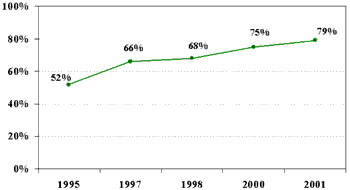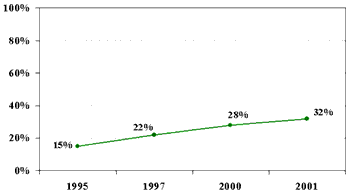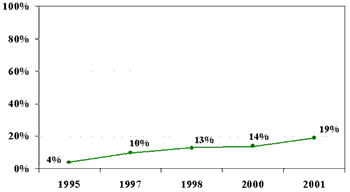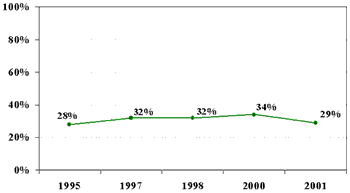GALLUP NEWS SERVICE
PRINCETON, NJ -- A ║┌┴¤═° poll conducted for the March of Dimes finds that women are increasingly aware of folic acid and the benefits it may have in reducing specific types of birth defects. However, less than one-third of women aged 18-45 say they take a multivitamin containing the recommended dose of folic acid each day. The percentage of women taking folic acid daily has actually declined in the past year. One in five women say they would be encouraged to take a multivitamin containing folic acid daily if their doctor or health care provider urged them to do so.
In 1992, the U.S. Public Health Service (PHS) recommended that all women who are capable of becoming pregnant consume 400 micrograms of the B vitamin folic acid per day to reduce their risk of having a pregnancy affected by neural tube defects. Common neural tube defects include spina bifida, which can cause paralysis in children, and anencephaly, a fatal condition in which a child is born with an underdeveloped brain and skull. In 1995, the March of Dimes Birth Defects Foundation received funding from the Centers for Disease Control and Prevention (CDC) to conduct a benchmark survey of women of childbearing age to assess their knowledge and behaviors relative to daily consumption of folic acid. The survey found relatively low awareness of folic acid and the PHS recommendation, suggesting the need for educational strategies to inform more women about the benefits of folic acid. Since that time, ║┌┴¤═° and the March of Dimes have conducted four follow-up studies to the initial benchmark. The results of the latest survey are presented below.
Awareness of Folic Acid
Since the benchmark study during 1995, there has been a steady increase in awareness of folic acid among women of childbearing age from 52% in 1995 to 79% in 2001. Similarly, more women today now say they have heard of the U.S. Public Health Service's recommendation regarding folic acid for women of childbearing age.
| Aware of Folic Acid (Based on all women aged 18-45) |
 |
Since 1995, awareness of the U.S. Public Health Service's recommendation regarding folic acid has more than doubled from 15% in 1995 to 32% in 2001.
| Aware of U.S. Public Health Service's Recommendation Regarding Folic Acid (Based on all women aged 18-45) |
 |
Women who say they heard or read something about folic acid were asked, unprompted, what they have heard about folic acid. Expressed as a percentage of all women, 19%, or about one in five, say folic acid prevents birth defects.
| Knowledge That Folic Acid Prevents Birth
Defects (Based on all women aged 18-45) |
 |
Vitamin Use
While awareness of folic acid and its benefits has continued to increase since 1995, in 2001 the proportion of all women aged 18-45 who report taking a multivitamin on a daily basis is 29%. Although this represents no change from 1995, there has been a significant decline in daily vitamin use since 2000.
| Take Vitamin Containing Folic Acid Daily (Based on all women aged 18-45) |
 |
Of women who werenotpregnant at the time of the survey, 27% report taking a vitamin containing folic acid daily, again similar to the 25% in 1995 who did so but a decrease from the 32% in 2000.
Women who do not take a vitamin or mineral supplement on a daily basis were asked what, if anything, would make them more likely to do so. Unprompted, 20% said they would be more likely to do so if their doctor or health care provider recommended they take it. Thirteen percent said they would be more likely to take a multivitamin daily if they had someone to remind them. A similar proportion (13%) report that they would be more likely to take a multivitamin daily if they experienced a change in their health. Seven percent report that they would be more likely to take a multivitamin daily if they felt run down.
Survey Methods
These results are based on telephone interviews with 2,001 women, 18 to 45 years old, conducted Apr. 14-May 22, 2001. For results based on this sample, one can say with 95 percent confidence that the maximum error attributable to sampling and other random effects is plus or minus 3 percentage points. In addition to sampling error, question wording and practical difficulties in conducting surveys can introduce error or bias into the findings of public opinion polls.
